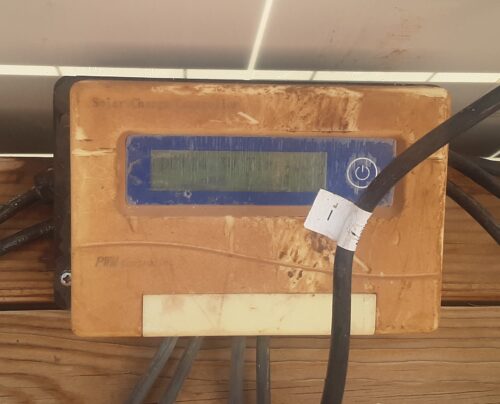
Hi there, K again continuing our conversation on photovoltaic systems. In this blog post, I want to talk about solar controllers, used for charging batteries from solar panels (discussed in Part 1). This post is highly technical, so brace yourself. But you need to know this to power your house and it’ll get easier as you see how the parts fit together towards the end of this series of posts.
Why do you need a controller?
On a typical 12 volt system, solar panels produce 16-18 volts. The 12 volt batteries need 13.5 to 14.6 volts to charge and anything higher would quickly destroy your batteries. So you need a controller to, well, control the volts going from your panels to your batteries. There are basically two types of solar controllers: the power width module (PWM) and the maximum power point tracker (MPPT). To understand how they work, let’s look at some terminology. When discussing photovoltaic systems, we come across the words volts, watts, and amps. But what do these words mean?
Volts, amps, and watts. Oh my!
There are many analogies out there to explain the relationship between volts, amps, and watts. An imperfect analogy people still find helpful is that of water in a garden hose. For electricity, the basic equation to keep in mind is: Volts * Amps = Watts. For the water hose analogy, voltage roughly translates to pressure and amperage roughly translates to the gallons of water per minute. Watts are the energy an appliance uses. For example, our refrigerator uses 750 watts in a day. To continue this analogy, the number of watts produced by a photovoltaic system depends on the volts (pressure) and amps (gallons of water per minute). Remember, this is a very imperfect analogy.
The types of solar panels and controller(s) you have create the amount of wattage and you can’t have a system without a controller. Below we’ll discuss the PWM controller, and in the following post we’ll discuss the MPPT controller and the differences between them.
PWM Controllers
The power width module (PWM) type of controller allows the full energy of the solar panels to go straight to the batteries. When the voltage of the battery reaches a certain point, the PWM will start interrupting the flow of power to maintain a preset voltage. PWM controllers are less expensive but less efficient.
Let’s take a 100 watt panel as an example. It’s called a 100 watt panel because the maximum voltage * the maximum amperage = the wattage of 100. If you have a 100 watt panel that puts out 18 volts, the maximum amperage would be 5.5 amps. With a PWM controller set to charge batteries at 13.5 volts, you would not get the maximum potential of 100 watts. Instead, you would get only 74.25 watts out of your solar panel (13.5 volts * 5.5 amps = 74.25 watts). These controllers are great for small systems, like on your RV or boat where you only use it occasionally, but not great for powering your home.
I know this blog post was technical, and will continue to be so as we look at the MPPT type of controller in the next blog post. It’ll make sense as you get towards the end of this blog post series, where we’ll put all the components together.
Next blog post: Part 3: Photovoltaic systems–types of solar controllers continued (by K)
